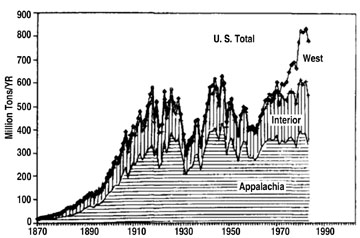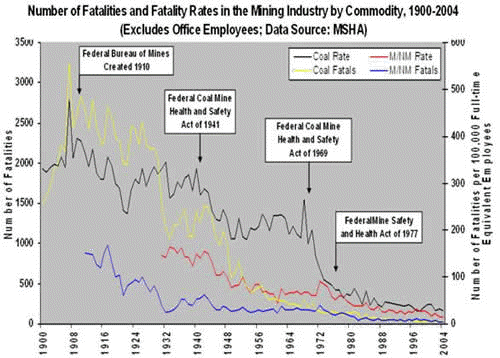Spring/Summer 2007, Volume 23.3
READING THE WEST
read-ing [from ME reden, to explain, hence to read] _ vt. 1 to get the meaning of; 2 to understand the nature, significance, or thinking of; 3 to interpret or understand; 4 to apply oneself to; study.
Coal and the American West

In the United States, coal is mined in three regions: Appalachia, the Midwest (Interior), and the West. The coals in the regions differ in their quality and concentration of impurities such as sulphur. The output of the Appalachian districts from Pennsylvania to Alabama has remained at about 300 million tons a year since about 1920. The production in the west was rather small (about 5 percent of the U.S. total) until around 1970 when a major shift in coal production occurred. Within the span of a decade or so, low-sulphur western coal captured a quarter of the United States coal market. Nowadays, the West provides 56% of the total.
Total U.S. production of coal in 2004 was about one billion tons, a 60% increase since 1973. About 92% of those tons are used to generate electricity.
Source: Rudolf B. Husar, "Sulphur and nitrogen emission trends for the United States: An application of the materials flow approach," in Industrial Metabolism: Restructuring for Sustainable Development, edited by Robert U. Ayres and Udo E. Simonis, The United Nations University, 1994; https://www.unu.edu. Also: "Coal at a Glance," The Need Project, 2005, https://www.need.org.
Utah—13th Leading Coal Producer
The North American Energy Working Group (NAEWG) was established among the three countries (Mexico, Canada, the United States) in 2001 to "foster communication and cooperation among the governments and the energy sectors on energy-related matters of common interest." In 2005 NAEWG became part of the trilateral Security and Prosperity Partnership (SPP). NAEWG reported in 2002:
-
Coal is transported mainly by rail.
-
The three largest coal-producing States are Wyoming, West Virginia, and Kentucky. Texas and Pennsylvania are also major producers.
-
Eleven other states also are significant coal producers: Alabama, Arizona, Colorado, Illinois, Indiana, Montana, North Dakota, New Mexico, Ohio, Utah, and Virginia.
Source: https://www.eia.doe.gov/emeu/northamerica/enginfr3.htm
Black Air/Black Lungs
In the United States, more than 50% of electricity is generated in coal-fired power plants. However, the use of coal has some dire consequences. Coal fired plants produce large amounts of carbon dioxide which contributes to global warming.
(Source: International Atomic Energy Agency, Bulletin 401, 1998; https://www.iaea.org)
And coal mining is a health risk. According to researchers at the National Institute of Environmental Health Sciences:
Coal mining itself is causing many environmental problems such as acid mine drainage, and the inhaled coal particles at the work place may lead to the development of coal workers’ pneumoconiosis (CWP)…. Among the occupations listed by the U.S. Census industry code, coal mining is the highest risk job associated with asthma death, with a proportionate mortality ratio of 1.98, compared with the second highest risk job of trucking service of 1.29….
Source: Xi Huang,Weihong Li, Michael D. Attfield, Arthur Nádas, Krystyna Frenkel, and Robert B. Finkelman, "Mapping and Prediction of Coal Workers’ Pneumoconiosis with Bioavailable Iron Content in the Bituminous Coals," Environmental Health Perspectives, 113 (August 2005 ); https://www.ehponline.org/members/2005/7679/7679.html.
Death in the Dark
Over the last century, significant progress has been made in reducing the frequency of mining fatalities. The National Institute for Occupational Safety and Health compiles the statistics.
Source: NIOSH Program Portfolio: https://www.cdc.gov/niosh/programs/mining/risks.html.
Blood on the Coal
Today the United States stands at an energy crossroads. A new generation of more than 150 coal-fired power plants is currently on the drawing board nationwide. The majority of these power plants will use antiquated pulverized coal technology, a system that makes it difficult and incredibly expensive to capture carbon dioxide. Even at the plants where the coal-burning technology allows for carbon capture, the sequestration of carbon dioxide underground remains untested on a large scale, and prohibitively expensive.
In addition, these so-called clean coal technologies do not address, in any way, the impacts of mining the coal. Of the nation’s roughly 73,000 coal miners, 57% work underground. According to the federal Mine Safety and Health Administration (MSHA), it had 584 inspectors in 2005, down from 634 in 1997. There were 2,620 mines in 2005 up from 2,053 in 1997.
Writing in Conservation Biology, Mary Hitt quotes Jeff Goodell from his book Big Coal (2006): "America’s vast reserve of coal is like a giant carbon anchor slowing down the nation’s transition to new sources of energy." Hitt summarizes her own analysis:
...the United States faces a choice: stay on the path of coal, carbon, and climate change for another 50–100 years or invest in truly clean forms of renewable energy. The consequences of this choice are monumental. Building a new generation of pulverized coal plants will lock the nation into another generation of massive carbon dioxide emissions. Building any kind of new coal plants without reforming our mining laws will lock [coal mining regions] into another generation of increasingly devastated landscapes and communities. Perhaps most important, building these new coal-fired power plants will postpone the inevitable shift to clean energy in the United States by destroying incentives for the development of new technologies. In the intervening years, we may well push the world’s climate past the tipping point.
Source: "Coal mine deaths spike upward," USA Today, January 2, 2007; https://web.ebscohost.com/; Hitt, Mary Anne Hit,. "America at the Energy Crossroads," Conservation Biology 21 (April 2007): 293–294; https://www.blackwell-synergy.com.
